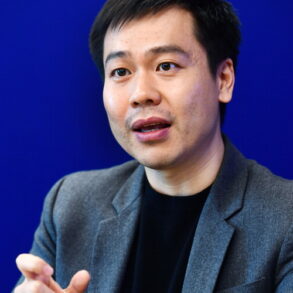A UPenn student started a YouTube channel. In weeks, her face was stolen on China’s social media.
Olga Loiek
- Olga Loiek, a college student with a YouTube channel, says she’s being used for deepfakes in China.
- She’s not the only one. Multiple caucasian women feature in pro-Russia deepfakes on China’s internet.
- Experts say it’s far easier for deepfakes of Western women to go unnoticed on China’s isolated web.
Olga Loiek was barely awake one mid-winter morning when she read a cryptic Instagram message.
“Do you speak any Mandarin?” it read in English.
Loiek had received similar messages in weeks prior from self-professed fans of her small YouTube channel, where she uploads self-empowerment videos to just over 15,000 subscribers.
Confusingly, several of those comments also lauded her command of the Chinese language.
Loiek doesn’t speak Chinese at all, the 20-year-old student told Business Insider from her apartment in Munich.
But this last message — sent in late January — was a warning, not a compliment. Someone may be trying to impersonate you, it said.
That message included a link to a video on Xiaohongshu, a social media platform rapidly gaining steam in China. The clip appeared to show Loiek speaking to the camera in Chinese as photos of the Kremlin and Russian leader Vladimir Putin jumped on-screen.
“At first, I kind of felt like, oh, it’s just a funny trick. But then I started translating it,” Loeik said. Bearing her face, the woman in the video spoke glowingly of Sino-Russian ties, bemoaning sanctions on Moscow while selling Russian products on a store page.
To Loeik, who is Ukrainian, it was outrageous. “I felt violated because these were things I would never, never say in my life,” she said.
Olga Loiek
Abuse of deepfakes, a swiftly developing technology that uses AI to replicate a person’s likeness virtually, has been documented for years.
But the crossover between Western faces and Chinese accounts presents a new layer of complexity, because China’s social media ecosystem is largely walled off from the world.
Deepfakes behind the Great Firewall
To China’s estimated 1.08 billion internet users, YouTube and Instagram are blocked and replaced by moderated alternatives to international platforms. There’s WeChat for WhatsApp and Facebook, Weibo for X, and Xiaohongshu as a mix of TikTok and Instagram.
On these Chinese platforms, deepfakes of non-Chinese women can often go undetected since viewers may not easily recognize the original person. Meanwhile, the creator is less likely to discover their face has been stolen because they, in turn, do not typically access the Chinese platforms where the theft is happening.
“In an ‘open world’ social media environment, when someone’s deepfake shows up, we can very easily demonstrate this is not real because we can find the original person,” said Lyu Siwei, a computer science professor who runs the Media Forensics Lab at the University at Buffalo. “But inside China, because it’s not so easy for Chinese users to go beyond the Great Firewall, they will not be able to do that cross-validation.”
Lyu and another AI researcher, Haibing Lu of Santa Clara University, told BI that over the last six months, they’ve observed what they suspect are other deepfakes of women on Chinese platforms like Douyin, China’s version of TikTok.
Loiek’s case shows that at least some of these deepfakes are non-consensual, they said.
The account that ran deepfakes of Loiek was described on Xiaohongshu as Natasha, a 31-year-old Russian woman who lives in China’s Heilongjiang province. The account had 140,00 followers — more than Loeik’s actual page. A store page affiliated with the account sold Russian candies for $3.60 per packet.
Olga Loiek, Xiaohongshu
Dozens of videos on “Natasha’s” page contained telltale signs of digital manipulation. For one, in these videos, Loiek’s lips are not always synced to the voiceover, which is in a mainland Chinese accent. There are times when the software fails, and her intonation is flat. The audio quality is also close to perfect, with no breathing sounds or background noise, which the two researchers said was a red flag.
“It was so creepy because I was literally seeing my face talk about things I would never condone,” Loiek said.
From one woman comes a dozen Russians
Loeik, who studies cognitive neuroscience at the University of Pennsylvania but is now in Germany for an internship, is unsure why these Xiaohongshu accounts chose her.
But whoever targeted Loiek found her fledgling YouTube channel in a matter of weeks.
The student started her self-empowerment channel in November and has so far published eight videos and seven YouTube Shorts.
In a YouTube video she uploaded in late January, Loiek asked her followers to help report the Natasha account. The dupe was removed from Xiaohongshu by February 25.
And while “Natasha” is gone, other accounts also bearing Loiek’s face have cropped up. Loiek said she’s discovered about 30 other accounts on Xiaohongshu that use her face and claim to be Russian.
Olga Loiek/Screenshot, Xiaohongshu/Screenshot
BI has seen some of them. There is April Annie, the Russian woman who moved to China eight years ago; Sophia Elena, who gushes about Russian ladies wanting to marry Chinese men; and Katyusha, who praises China and Russia’s partnership. All use deepfakes of Loiek.
The Xiaohongshu deepfakes of other YouTubers do the same. The perpetrators seem to target female creators who upload easily accessible content of themselves but aren’t major celebrities.
These accounts aren’t hard to find, as the Xiaohongshu app often suggests pages similar to the one you’re already viewing. In a matter of about 10 minutes, BI found deepfake videos of at least five caucasian women on Xiaohongshu. In all of these videos, the deepfake doppelgangers fawned over and praised Russia and China.
Lana Blakely is one of them. Blakely is a Stockholm-based content creator who has 1.6 million subscribers on YouTube, where she discusses topics like self-reflection and managing relationships. But at least one Chinese deepfake version of Blakely has a different agenda to share on Xiaohongshu.
“When we were young, we learned in school that China and Russia are brothers in hardship,” a deepfake version of Blakely says in Chinese in a video BI viewed.
Screenshot/Lana Blakely and Xiaohongshu
London-based Elizabeth Filips, who has 950,000 subscribers on YouTube, uploads videos covering neuroscience tips and personal improvement. On Xiaohongshu, an account posted deepfakes of her discussing China’s international relations.
“China has three good friends. The first is good brother Pakistan, there is good brother Serbia, and lastly, the good brothers China and Russia,” said a deepfake version of Filips in one video.
Elizabeth Filips/Screenshot, Xiaohongshu/Screenshot
Blakely declined through her talent management agency to comment. Filips did not respond to requests for comment sent by BI.
On the dozens of videos reviewed by BI, not a single Chinese user commented with suspicions that the clips were manipulated.
“The messages are consistent with what they’re already exposed to, that China is great,” said Lyu. “And I think on top of that is that a beautiful young woman of foreign origins is speaking Chinese. That adds to the curiosity factor and attracts Chinese viewers.”
When asked about the deepfakes, a Xiaohongshu spokesperson told BI: “As artificial intelligence has continued to develop, Xiaohongshu encourages and values its innovations. At the same time, many risks have emerged due to AI-generated content on online platforms.”
They pointed to the platform’s guidelines, which prohibit impersonation and posting content that is not “based on real experiences.”
Origins still obscured
Though Loiek succeeded in shutting down the Natasha account, the people creating these videos are still a mystery.
New accounts purporting to be her surface occasionally. One account that once used her face as a profile picture started uploading videos of cats.
Screenshot/Xiaohongshu
AI has been extensively reported to often be a tool for propaganda, even outside China. US intelligence agencies have accused both Russia and China of using deceptive methods to sway public opinion and cited AI as a prime concern.
But Lyu said it’s unclear if these deepfakes are part of a government operation or an effort by a third party, such as a pro-Russia or pro-China group.
The Chinese and Russian foreign affairs ministries did not respond to requests for comment sent by BI.
The culprits could also simply be experimenting with deepfakes in China, said Vincent Conitzer, the head of technical AI engagement at the Institute for Ethics in AI at Oxford University.
“Let’s see what we can do. Let’s see how people react. Do people buy it?” Conitzer said of the possible mindset behind the videos’ creation. “Sometimes there might even be an aspect of, ‘Let’s see how people react to it,’ even when they can pretty clearly identify that it is fake.”
No good options for Loiek
AI experts like Lyu say Loiek is taking the best course of action available by drawing attention to the deepfakes and asking her followers to report them.
Few other options are realistically available to her, they said.
Lu, an information analytics professor at Santa Clara University, is another researcher besides Lyu who’s recently seen deepfakes like Loiek’s on Chinese social media. He told BI that he’s tried to report them to the Chinese authorities.
Filing an internet crime report typically requires a Chinese ID, akin to a Social Security number, he said.
“It would be very difficult for foreign victims to report this,” Lu said. “Technically, it’s impossible.”
Nirupam Roy, an assistant professor at the university’s computer science department, said his team is working on an anti-manipulation software called TalkLock that can flag altered content.
But fighting deepfakes like this would require companies like Xiaohongshu to come on board and use such software.
“The push for a standard measure like this typically depends on how aware people are of the problem,” Roy said.
And with no international agreement yet on AI issues, it would be difficult for Loeik to sue even if she found the culprits, said Ari Lightman, a digital media professor at Carnegie Mellon University.
“These things are going to happen over and over again,” he told BI.
Meanwhile, Loiek says she’ll still work on her channel despite knowing that any content she uploads can become a deepfake in China.
“I don’t think I have to think from a place of fear,” she said. “But I understand every time I post a video, there’s a possibility that it can happen.”
This post was originally published on this site be sure to check out more of their content







